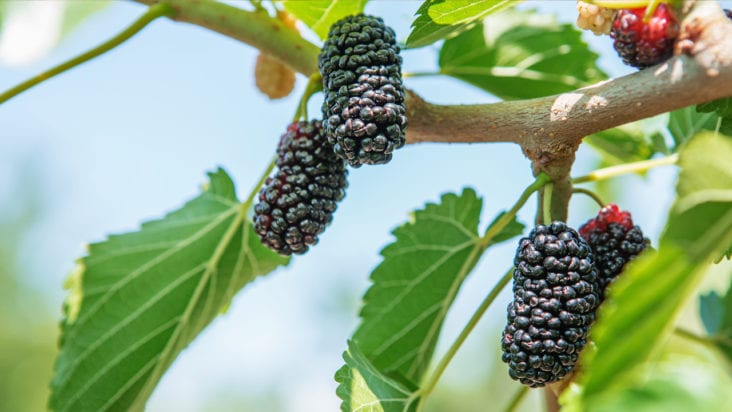The mulberry tree is often confused with a bush, as people think they are a bush plant. Actually, these trees can be enormous, and if they are left to grow wild and unchecked, some varieties are capable of growing 80 feet high and spread a wide canopy that will easily engulf an entire lawn in shade. While other berry plants can grow lower to the ground and make beautiful little hedges, mulberries are something else entirely.
Honestly, mulberries are not at all famous as other berries, and their reputation is not on a high level. The berries stain the driveways, while its trees reproduce like weeds and tend to attract insects and produce a lot of pollen. Despite all of this, a mulberry tree is one of the top trees people pick for their gardens.
1. Crazy Abundant
Berry bushes supply a lot of food, so just think of what this big tree is capable of. Mulberry trees are as productive as they come, and some can give a few hundred pounds of fruit per year. They are not so popular because they bruise and leak very easily, so they are not for commercial use.

2. Deliciously Available
You can pick them at home and enjoy the huge harvest all by yourself. The berries are edible right after the harvest, and you can always freeze them for later use. They are also great when dehydrated. Like the rest of their relatives, these berries are perfect for pies, ice creams and yogurts. A bit harder to make but also a tasty treat is a homemade wine.
3. Edible Diversity
Surprisingly, mulberry leaves are also edible. You can use them in salads, or in “stuffed” leaf recipes. Some cultures have great respect for the leaves in medicinal practices, as they help with blood sugar levels. Keep in mind that they must be cooked before being edible.
4. Fast-Growing
Unlike some other productive tree crops, mulberry trees are famous for growing quickly. Most trees need between five and ten years to start bearing fruits. With mulberries, some varieties start to produce fruit in the second year and slowly give more and more towards maturity, which is around ten years later. The tree becomes bigger quickly and will provide plenty of shade under it, reward your cultivation efforts.
5. Climatically Tolerant
There is a large variety of mulberry sorts, so wherever you live, there is a respective mulberry variant that is perfect for the region. They work from zone three to zone nine, and only hot tropics and arid deserts are a true challenge for them. The trees are very resistant to droughts, and can withstand temperatures that go deep into the negatives, and have only small issues with hard winds. Basically, a mulberry tree is a big, beautiful tree that works well in most places.

6. Animal-Friendly
Because the plant is so abundant and delicious, they are extremely popular with wildlife like silkworms, insects, and birds. Many planters and farmers use them smartly to distract wildlife from their prime and more important production crops. Similarly, true nature lovers who wish to attract birds to their garden property can utilize this feature. Do not worry about the fruit, as the mulberry tree produces enough for all: birds (berries and bugs), silkworms (leaves), and people (berries and leaves).
7. Shade-Producing
As we already mentioned, mulberries are tall and sprawling trees, which makes them great for providing shades. They will cover a corner of your precious yard in no time. Utilize this to make a strategic spot for a hammock, or even a small patio. They are also deciduous and lose the leaves during winter. This means you get the necessary sunlight when cold, and the all-important shade during the hot summer days!
We hope that these seven reasons persuaded you to plant the amazing utility plant that is the mulberry tree. You will have tons of berries and leaves to eat, nice shade in the yard, a beautiful tree to make it all look amazing, and animals for a picturesque overall vibe!

